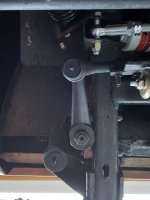Just got Duffs dual sport Heim steer installed on my Bronco… but my trac bar and drag link don’t align perfectly. Ironically they did before, but saddle in Duff tie rod sits higher…
Don't think I've noted that much misalignment before, but maybe was not paying attention.
Just out of curiosity, what was your previous setup? Stock? Original even?
I’m wondering if I need to move pitman arm over a notch to be more parallel with the frame. (I have power steering BTW).
What year is the gearbox and pitman arm?
It's normal for the first few years (including the early power steering) to have the pitman arm offset one spline, or 10° to the driver's side. So it's not a big deal.
However, Ford did change later versions to a straight-back orientation, so there's that. My opinion is that you can use whatever works.
Just always make sure that the gearbox is in it's centered position first, then set everything off of that. Including the steering wheel, which is always our first visual cue as to steering box position. The on-center location is very important, so when in doubt, always double-check that.
Axle is centered under frame, pitman arm is clocked and at center of gear box.
What exactly does that last bit mean? That the arm and box aim straight back when centered, but that it has to be offset like that to fit? The box is not centered when at ride height in other words?
I’m wondering, if moving the pitman arm a tad will help? Or if I’m going to have to get trac bar riser bracket from Duff, which I was told I wouldn’t need for a 2.5” lift and tie rod under install.
I'm sorry that as an industry as a whole, we still quote that old nonsense about not needing drops or arms until you get to 3" and above. Even we still do it...
For me, because 2.5" is ALMOST 3 INCHES I say all EB's can benefit from the drops with 2.5" lifts. I only go back to the old rules at 2" and below.
And even then I would like to see some custom pitman arms and drop brackets that work with 1.5-2 inch lifts!
Stock steering angles are better than non-stock steering angles every time.
I can't say for a fact since I did not make the original rules 50 years ago, but I always felt that the early modifiers (and their customers) just were cheap and did not want to spend the money on custom modifications of the steering linkage until it was absolutely necessary. Hence the rule for 3" and above absolutely needing drops, and anything below that was just a 'user's choice" kind of thing. And since most of us Bronco owners were cheap (there, I said it again) we ignored, and just plain did not care that they did not handle like stock anymore. We put up with it back then just fine.
But back then too, most lifts under 3" were in fact 1.5 inches or less. So that might have been the driving factor initially, and when 2 and 2.5 inch lifts came out, the old "3 inch rule" held up in court and our cheapness prevailed and nobody wanted to spend another 50-100 bucks if they didn't have to.
Nowadays however, with Bronco values being in the multiple tens and hundreds of thousands of dollars, spending another 150 bucks to have it handle and steer better seems like nothing. So I think the vendors (all of us) should modify our old-school thinking and just tell customers it's best to take the plunge and add the parts for anything 2.5 and above. And spend more time with them on the phone even if it means longer wait times for calls, to explain the reasoning why the extra money is well spent.
Are they absoulutely necessary? No, still not. But with more owners being more particular about how their old SUV's handle and steer and stop, compared to thirty and forty years ago, it's time to make them at least more desirable rather than avoiding them altogether.
It's just a better practice...
We'll see who's the first to change with the times. Hopefully it's us!
Rather than a riser in your case though, I would get one of their trackbar drop brackets. But you've got a second and a third layer of dilemma here, with the non-parallel bars and maybe even the non-original gearbox and pitman arm.
If we're not concerned with overall angle, a Duff drop bracket with the multiple holes (or the short one if they still sell that model?) would probably put your trackbar right inline with the pitman arm as it sits now. That's your easiest and least expensive first level solution. It does nothing for angles, but gets the parallel aspect back to snuff.
If it was me I'd try to figure out how to do both. Get them parallel AND get them both lower as well.
Maybe that takes a full drop bracket and custom pitman arm? Or a riser after all, so you can fine tune your trackbar angle (multiple holes) to the new dropped pitman arm?
I'm not sure what your best solution is at the moment. Only the first step easy solution. Because I'm not sure why the new steering put your angles out of parallel yet.
The gearbox and pitman arm change were prior to this, correct? So the same setup had parallel bars? Got any pics of before?
By the way, is that big thingy that looks like a metal angle-iron bracket welded to the crossmember some kind of drop for the steering stabilizer? Was this Bronco lifted to the moon before? Or am I just seeing it wrong and it's something you're using to check axle centering maybe?
Good luck.
Paul
















